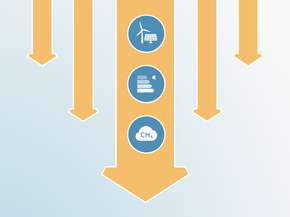Current Policy Projections
Current policies overview
According to the most recent national emissions projections, with currently implemented policies, total national GHG emissions excluding LULUCF are projected to stabilise around current levels, reaching 79 MtCO2e in 2020 and decreasing to 76 MtCO2e in 2030. This represents an increase in emissions from 1990 levels of 19% in 2020 and 15% in 2030, which is equivalent to an emissions reduction of around 7% compared to the ‘without measures’ or “Business as Usual” national scenario (excluding LULUCF) and thus, on its own, not strong enough to meet domestically New Zealand’s 11% emissions reduction below 1990 levels as proposed in the 2030 target (Ministry for the Environment, 2017b).
Emissions from the industry and transports sectors are projected to continue growing until 2030. This growth, however, is projected to be compensated by emissions reductions in the energy and agriculture sectors, with a net-zero growth of total emissions excluding LULUCF by 2020 and a 4% reduction of emissions excluding LULUCF by 2030, both compared to 2015 (Ministry for the Environment, 2017b). Additionally, the LULUCF sector, which historically has represented a big carbon sink, will see a progressive reduction (from -24 MtCO2e in 2015 to approximately -16 MtCO2e in 2020 and -4 MtCO2e in 2030) mainly due to increasing deforestation, a reduction in new forest plantings and reduced absorption capacity of forests due to aging.
Currently, expected emissions levels are still far from the government’s emissions reduction targets for both 2020 and 2030, which means New Zealand should significantly strengthen its current policies and implement new mitigation measures to comply with its international commitments, if it is not to rely on imported carbon credits. To be on track for its long-term target of a 50% reduction of emissions below 1990 levels, New Zealand’s emissions would need to peak and start declining at much higher rates of reduction post-2030. The absence of strong policy to reduce agricultural and transport sector emissions will make achieving New Zealand’s targets difficult and costly in the long term (OECD, 2017).
New Zealand’s main instrument to reduce greenhouse gas emissions is an Emissions Trading Scheme (NZ-ETS) (Ministry for the Environment, 2013). Forestry was the first sector to enter the NZ-ETS in 2008, followed by liquid fossil fuels, stationary energy and industrial processes in 2010, and waste and synthetic greenhouse gas sectors in 2013. The agriculture sector, responsible for around 50% of New Zealand’s emissions, is currently exempt from the NZ-ETS. There is also no cap on total emissions, and hence no quantitative constraint on the overall level of emissions.
Since June 2015, the NZ-ETS transitioned into a domestic-only scheme, with only national units now eligible to meet surrender obligations. This change has resulted in a slow but steady increase in the carbon price since then (New Zealand Government, 2016d). From 2015 to 2017 New Zealand undertook a review of its ETS (New Zealand Government, 2016b) and proposed a range of additional measures that—if introduced—would strengthen the NZ-ETS in the future. These include: ending the transitional phase arrangement of requiring only one unit to be surrendered for every two tonnes of emissions generated between 2017 and 2019, introducing auctioning of units to align the NZ-ETS to climate change targets, and limiting the use of international units when the NZ-ETS reopens to international carbon markets (Ministry for the Environment., 2017).
On 26 October 2017, New Zealand’s new coalition government was officially sworn in. While it is too early to quantify its new policies, it is clear Prime Minister Jacinda Ardern’s government is preparing to introduce a much-needed, stronger climate change regime, aiming for a “Net Zero Economy” by 2050 and 100% renewable electricity by 2035. The Parliament has also recently passed a bill banning new offshore oil and gas exploration (NZ Herald, 2018). Under agreements with its coalition partners, the Government plans enact a Zero Carbon Act (which would set up an independent Climate Commission), strengthen the ETS (possibly including agricultural emissions that make up half of the country’s GHG emissions), build regional rail systems, cancel road building projects, plant a billion trees, and start a NZD 100 million Green Investment Fund to stimulate investment in low carbon industries (House of Representatives of New Zealand, 2017). Regarding the possibility of including agriculture in the ETS, the coalition agreement specifies that upon entry, the free allocation to agriculture would be 95% and all revenues from this source would be recycled back into agriculture in order to encourage agricultural innovation, mitigation and additional planting of forests.
The new government in August 2018 outlined proposals for a first stage of reform of the operation of the ETS (Ministry for the Environment, 2018b). Key changes proposed include:
- Introducing the auctioning of units;
- Removing the option to pay a fixed price for emitting while not holding a valid emissions unit and establishing instead a mechanism to partially cap the ETS price by holding a quantity of units in reserve for discretionary release;
- Limiting the use of international units; and
- Progressively lowering the quantity of units gifted to industrial emitters.
These reforms are broadly in line with the recommendations of the NZ Productivity Commission which concluded that the NZ ETS needs to be reformed to improve control over unit supply (i.e. effective caps on emissions) and have an institutional architecture to underpin a credible and efficient market in emissions units (Productivity Commission, 2018).
The New Zealand Government had tasked the Productivity Commission to look at how New Zealand can maximise the opportunities and minimise the costs and risks of transitioning to a lower net emissions economy. In August 2018, it published a its final report (Productivity Commission, 2018). This flags three key activities to set New Zealand on a path to achieving its mitigation goals: replacing fossil fuels with renewables, reducing emissions intensity in agriculture, and changes in land use in favour of afforestation. It notes that while forestry will play a part in achieving net-zero emissions by 2050, it cannot take the place of actual mitigation measures (Productivity Commission, 2018). In addition to reforming the ETS, the Commission recommends introducing effective and strong carbon pricing, transforming the country’s transport system, enshrining the GHG targets in law, and targeted interventions across the economy.
Given that all the measures suggested by the new government are still under development, we cannot quantify the potential impact of these policies in emissions projection in this update. The estimates presented in this report reflect only policies included in the latest national emissions projection.
Energy supply
New Zealand’s energy intensity ranks seventh-highest among IEA member countries (International Energy Agency, 2017). Under the previous New Zealand Energy Efficiency and Conservation Strategy 2011–2016 (NZEECS), the government’s energy efficiency target was to achieve a rate of energy intensity improvement of 1.3% per year. So far this target has not been met; the energy intensity level in 2015 was the same as in 2011. The energy intensity target has been dropped out of the revised 2017–2022 NZEECS, released in 2017 (New Zealand Government, 2017).
In the electricity generations sector there is a domestic target to increase renewable electricity to 90% of total generation by 2025, (Ministry for the Environment, 2015), and 100% by 2035. In 2015, renewable sources made up 80.8% of electricity generation, a level that has been high in New Zealand for decades, due to the availability of extensive historical hydro generation along with more recent wind and geothermal plants. There are very few policies in place that would support this increased renewable energy target, and reliance is instead being placed on the relatively low cost of renewable sources.
In some regions, power distribution companies are now imposing an extra charge on new solar power users, with the High Court indirectly giving the green light to this “solar tax” by ruling against a request from solar companies for a hearing to contest the charge (High Court of New Zealand, 2017). There are also at least two proposed gas-fired power stations in various stages of the consent process (Frykberg, 2016).
In its issues paper, the Productivity Commission states that “there are no technical barriers to the generation of more electricity from renewable sources” and that “the relative cost and efficiency of renewables, such as wind power, now make them a price competitive option” (New Zealand’s Productivity Commission, 2017). However, the Commission also recognises that increased reliance on renewable sources of electricity will pose challenges for New Zealand’s current regulatory, institutional and infrastructural arrangements for the supply of electricity. Major regulatory changes in the renewable energy sector are recommended in the final report of the Commission (Productivity Commission, 2018).
Industry
Industrial processes and product use (mainly iron, steel and aluminium production) are responsible for around 6% of New Zealand’s total emissions excluding LULUCF. The main GHGs directly emitted by industry are CO2 (two thirds of emissions), followed by hydrofluorocarbons (HFCs). For this sector, New Zealand supports the Montreal Protocol to phase down HFCs worldwide and a consultation has led to an expert working group report. It is unclear as to the action the Government will take from here. New Zealand implementing the agreement would lead to an 80% reduction over the 2019–2036 period. However, this would cut NZ’s GHG emissions by only 2% (New Zealand Government, 2016a).
The government currently has a target to reduce industrial emissions by at least 1% a year between 2017 and 2022, with a particular focus on process heat. However, according to the Productivity Commission, the achievement of this target is difficult under the current setup of the NZ-ETS, where emissions intensive and trade exposed industries are freely allocated the majority of their NZU requirements to support their international competitiveness and prevent leakage of production and emissions offshore (New Zealand’s Productivity Commission, 2017; Productivity Commission, 2018)
Transport
Transport is the second biggest source of emissions in New Zealand (around 19% of total emissions excluding LULUCF in 2016) and under current policy projections emissions from this sector are expected to continue growing at least until 2030 (Ministry for the Environment, 2017b). New Zealand’s level of vehicle ownership is among the highest in the world; its light vehicle fleet is one of the oldest among developed countries (New Zealand’s Productivity Commission, 2017), and there are no emissions standards for passenger vehicles. A key reason for the age and poor fuel economy of the car fleet is that most vehicles entering New Zealand’s fleet are used imports, while most vehicles in other OECD countries enter the fleet as new. The dominance of used imports, while damaging to the climate, has been hugely important for reducing the cost of vehicle ownership for low-income households, pushing upward vehicle ownership (Productivity Commission, 2018).
In 2016 the government announced its Electric Vehicles Programme aimed to encourage the uptake of electric vehicles (EVs), with a target of going from around 3,800 EVs in 2017 to 64,000 EVs registered in New Zealand by the end of 2021 (New Zealand Government, 2016a). According to the most recent national projections, this policy, together with the vehicle fuel economy labelling, and the Voluntary Biofuels Sustainability Reporting Scheme will reduce transport emissions by only 1% compared to a “without measures” scenario by 2030 (Ministry for the Environment, 2017b).
In 2017, the new government listed in its coalition agreement measures for the transport sector including the target of a carbon-free government vehicle fleet by 2025/26 and “significant investments” in regional rail infrastructure (House of Representatives of New Zealand, 2017).
Agriculture
New Zealand invests in agricultural greenhouse gas research but lacks any strong policy to reduce emissions in the sector. The expansion of New Zealand’s dairy industry has seen emissions from this sector rocket up, with (non-CO2) emissions from agriculture now accounting for around half of the country’s emissions. Despite its huge contribution to GHG emissions, the agriculture sector is exempt from the NZ-ETS.
Recent modelling, conducted in the context of the long-term target options, shows the importance of reducing agriculture emissions as a mitigation policy: a new report by the Parliamentary Commissioner for the Environment concluded that holding New Zealand’s livestock methane steady at 2016 levels would cause additional warming of 10–20% above current levels by 2050 and that if New Zealand wished to ensure that methane from livestock caused no additional contribution to warming beyond the current level, emissions would need to be reduced by at least 10–22% below 2016 levels by 2050, and 20–27% by 2100 (Parliamentary Commissioner for the Environment, 2018).
Independent submissions, in the context of the long-term target consultations, confirm the need to methane and other non-CO2 emissions in parallel to reducing CO2 emissions to be consistent with achieving the Paris Agreement goals at the national level in New Zealand (Hare, Schleussner, Schaeffer, & Nauels, 2018). The most recent IPCC report confirms this finding and concludes that pathways that limit global warming to 1.5°C with no or limited overshoot involve deep reductions in emissions of methane (35% or more below 2010 levels) by 2050 (IPCC, 2018).
In its report, the Productivity Commission identifies mitigation options for the agriculture sector, including improving farm-management practices; targeting the amount of CH4 produced by animals; reducing the amount of nitrous oxide emitted from soils; and reducing livestock numbers (New Zealand’s Productivity Commission, 2017; Productivity Commission, 2018). Regarding the imposition of a price on agriculture sector emissions, the Commission states that “exempting agriculture from an emissions price places a disproportionately (and inefficiently) high emissions reduction burden on other sectors in the context of meeting New Zealand’s emissions targets”; and that “applying a price to agricultural emissions would give farmers more incentives to adopt mitigation options, though the size of the effect is uncertain.” (Productivity Commission, 2018).
The findings of the Productivity Commission confirm previous results by other modelling groups that a trajectory toward emission-neutrality around mid-century requires substantially strengthened action in the agriculture and forestry sectors in addition to efforts to decarbonise the energy system (Vivid Economics, 2017).
Forestry
The Land Use Land Use Change and Forestry (LULUCF) sector has historically represented a big carbon sink that offset on average 40% of gross GHG emissions between 1990–2016 (average -29 MtCO2e yearly). Indigenous forests cover 29% of New Zealand’s land area and a further 8% of land is occupied by commercial forests (New Zealand’s Productivity Commission, 2017). However, the sink has lost importance over time, going from offsetting 45% of total emissions in 1990 to offsetting only 29% in 2016. Unless additional policies are implemented, this sink will continue to see a progressive reduction, going from -20 MtCO2e in 2015 to approximately -16 MtCO2e in 2020 and -4 MtCO2e in 2030. This trend is mainly caused by a cyclical bulge in harvesting of the forestry crop, along with: increasing deforestation; reduced new forest plantings; and reduced absorption capacity of forests due to aging.
As confirmed by the Productivity Commission in its report, this sector has a big mitigation potential in New Zealand. The Commission states that “new forests is currently the only large-scale mitigation option that can easily be implemented to sequester large amounts of carbon dioxide from the atmosphere” and acknowledges the big national potential for afforestation and reforestation measures (Productivity Commission, 2018). In this context, the Government has set a goal to plant one billion trees between 2018 and 2027 (MPI - Ministry for Primary Industries., n.d.), but it is unclear what the mitigation potential of this policy will be as the mix between exotic trees and permanent indigenous forests is not clear. However, the report also identifies the difficulties of providing the appropriate incentives to achieve a sustainable and substantial increase in afforestation activities, especially under the current structure of the NZ-ETS and invites stakeholder to make submissions with options to address these challenges.
As part of the proposals for reforming the operation of the ETS, the government is proposing changes for the forestry sector, intended to “simplify the way the ETS works for forestry participants, increase afforestation and enable more flexibility in the scheme rules to support the right trees being planted, in the right place, for the right purpose”(Forestry New Zealand, 2018a). Key changes in the options outlined by the government include:
- A significant change to the ETS accounting approach for calculating and rewarding forest carbon for new forest planting called “averaging” accounting. Under this approach, forestry participants would earn payments of emission units that represent the carbon increases in their forest, up until their forest reaches a level of carbon storage that represents the average carbon stock it will hold over the long term, and they would no longer face any liabilities on harvest. The carbon storage average for forests registered in the scheme would vary depending on factors that affect carbon yield including the region and forest type.
- Introducing offsetting for all ETS participants that are eligible for averaging. Offsetting allows foresters to avoid deforestation liabilities if they establish a forest elsewhere of equal or greater size in area.
- Introducing a mechanism for recognising emissions mitigation from harvested wood products (HWP). This would mean amending the calculation of the average carbon stored in ETS forests to include extra units to recognise deferred emissions from HWP and increase the average crediting age for the ETS forests.
- Creating new permanent forest activity (indigenous trees or exotic species which are not harvested or harvested on very long rotations) in the ETS.
- Introducing a package of operational changes to improve the way the ETS works for forestry participants.
The effect of these proposed changes on overall emissions and the role of these new rules in the achievement of the emissions reduction targets has yet to be seen, as there has been little transparency around these rules, and many of the details and options are still under discussion.
Further analysis
Latest publications
Stay informed
Subscribe to our newsletter




